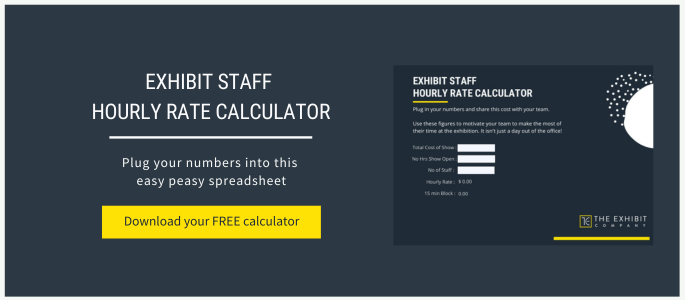Everyone has different priorities when it comes to attending trade shows. There is no right or wrong, but regardless of your key objective knowing your numbers is a smart move. A lot of people really struggle with calculating trade show ROI so it’s usually something that get’s left off the to-do list.
- Are you guilty of judging the success of a show by how it feels rather than the numbers?
- Do you want to look sharper than the competition?
- Or is your main goal to have the stand that attracts all the crowds and is the place to be?
While tracking too many things can send your head into a spin, not calculating enough means you can’t weigh up if a show was worth the investment or benchmark your success across future shows. I would love for people want people to start getting serious about their attendance so today I’ve included a bonus download at the bottom of this blog to help work out one of the most important (and forgotten figures).
At the end of the day, you should be going to an event to make progress. Progress people through your sales cycle, get new leads, brand awareness because you’re new to the market…
Whatever you pick as your number one mission, calculating your exhibit return on investment is an important part of the process. Sticking your head in the sand and NOT measuring means you don’t learn from your attendance because you can’t honestly highlight areas that went poorly (or well, for that matter).
Going by your gut doesn’t count.
Even if fewer people are attending a show, you might find that the quality has gone up. (This is defintiely the trend for 2022) Just because people aren’t spending as much time at each show, doesn’t mean they have less of an impact. There are so many touch points to a sale these days, but most of them are online experiences. Face-to-face marketing isn’t ever going to die. If anything, I predict we are going to value human interactions much more in the future.
It’s worth noting that many visitors are managing their time more. They tend to decide which stands they plan to visit before they even step foot in the show! To work out the cost of the show, consider your space booking, cost of your exhibit, marketing expenses, freight, travel and expenses and giveaways.
Two numbers you really need to track:
- Your KPI’s
- Hourly rate/staff time
Knowing your staff hourly rate highlights the true cost of your conversations and helps keeps your staff on point at the show. Below I’ll describe how to do the jungle maths, but if you want the easy option, download the bonus at the bottom of this blog and you can drop in your figures. Easy peasy!
Interaction capacity
This is the maximum number of people you can comfortably talk to during a show. This vital number is often not considered when looking at the true cost of a show. I recommend contacting the organiser of a show to find out how many of your target market attended their last show. For this example, let’s assume 450 people.
Multiply No. of hrs show is open X No. staff X No. of interactions/hr per person
3 days / 6 hrs per day / 2 staff / 10mins each so 6 per hr per person
18hrs x 2 staff = 36 36 x 6 interactions = 216 is your interaction capacity
This shows us, you can expect to miss out on 234 potential interactions at this event. Just a fact. If you want to lower this number you have a few options: Spend less time with each visitor, get more staff, or find another way to get your message across.
Cost per hour
Total show investment divided by No. of staff hours Budget $15,000 divided by 36 = $416.66 per hour
Cost per interaction
Budget divided by 216 = $69.44 per interaction
Do these calculations before the show for cost analysis, then after the show on the revenue side. Then compare with attendance at other shows.
Then the magic happens
Using this type of thinking will allow you to work out the cost of your leads and how much business you got as a result. You want to look at how many were good leads (and how many weren’t), which moved ahead at that show, 3mths, 6mths after… Did your staff speak to enough people? If not, why not? Were numbers low because you were under staffed (or had the wrong staff on the stand)? Or…
- Your message wasn’t articulated properly?
- Not enough of your target market were at that show?
- A poor stand position?
Think broad and really question your numbers. Yes, it’s super nerdy… But, oh, so important!
You didn’t ask for it, but my belief is…. Those who don’t work out their ROI probably don’t really want to really know the answer. I’ve noticed that these people are usually also the ones who go to a show “because they have to”. They’re the ones who are doing what they’ve always done and have practically given up already. This is the level of thinking that SHOULD be done before deciding whether it’s the show that’s not working or your approach.
Then it’s time to workshop ways to track your leads – This blog is a good one for that.
If you’re maths skills are as good **cough** as mine, you might like this with all the formulas in it to track your staff hourly rate. It’s a good start in getting your numbers on track.

You’re welcome!
Want more support in taking your trade shows to the next level? Get in touch for a general chat.
Jess, Chris & Petra 🙂
